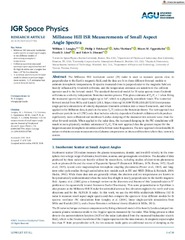| dc.contributor.author | Longley, William | |
| dc.contributor.author | Erickson, Philip J. | |
| dc.contributor.author | Vierinen, Juha | |
| dc.contributor.author | Oppenheim, Meers | |
| dc.contributor.author | Lind, Frank David | |
| dc.contributor.author | Dimant, Yakov | |
| dc.date.accessioned | 2021-05-03T09:27:50Z | |
| dc.date.available | 2021-05-03T09:27:50Z | |
| dc.date.issued | 2020-05-04 | |
| dc.description.abstract | The Millstone Hill incoherent scatter (IS) radar is used to measure spectra close to perpendicular to the Earth's magnetic field, and the data are fit to three different forward models to estimate ionospheric temperatures. IS spectra measured close to perpendicular to the magnetic field are heavily influenced by Coulomb collisions, and the temperature estimates are sensitive to the collision operator used in the forward model. The standard theoretical model for IS radar spectra treats Coulomb collisions as a velocity independent Brownian motion process. This gives estimates of <i>T<sub>e</sub>/T</i><sub>i</sub>< 1 when fitting the measured spectra for aspect angles up to 3.6°, which is a physically unrealistic result. The numerical forward model from Milla and Kudeki (2011, https://doi.org/10.1109/TGRS.2010.2057253) incorporates single‐particle simulations of velocity‐dependent Coulomb collisions into a linear framework, and when applied to the Millstone data, it predicts the same <i>T<sub>e</sub>/T</i><sub>i</sub> ratios as the Brownian theory. The new approach is a nonlinear particle‐in‐cell (PIC) code that includes velocity‐dependent Coulomb collisions which produce significantly more collisional and nonlinear Landau damping of the measured ion‐acoustic wave than the other forward models. When applied to the radar data, the increased damping in the PIC simulations will result in more physically realistic estimates of <i>T<sub>e</sub>/T</i><sub>i</sub>. This new approach has the greatest impact for the largest measured ionospheric densities and the lowest radar frequencies. The new approach should enable IS radars to obtain accurate measurements of plasma temperatures at times and locations where they currently cannot. | en_US |
| dc.description | Published by AGU. Copyright (2020) American Geophysical Union.
<p>
Longley, W. J., Erickson, P. J., Vierinen, J., Oppenheim, M. M., Lind, F. D., Dimant, Y. S. (2020), Millstone Hill ISR Measurements of Small Aspect Angle Spectra, Journal of Geophysical Research: Space Physics, volume 125, issue 6. <a href=https://doi.org/10.1029/2019JA027708>https://doi.org/10.1029/2019JA027708</a> | en_US |
| dc.identifier.citation | Longley W, Erickson PJ, Vierinen J, Oppenheim M, Lind FD, dimant. Millstone Hill ISR Measurements of Small Aspect Angle Spectra. Journal of Geophysical Research (JGR): Space Physics. 2020 | en_US |
| dc.identifier.cristinID | FRIDAID 1873691 | |
| dc.identifier.doi | https://doi.org/10.1029/2019JA027708 | |
| dc.identifier.issn | 2169-9380 | |
| dc.identifier.issn | 2169-9402 | |
| dc.identifier.uri | https://hdl.handle.net/10037/21121 | |
| dc.language.iso | eng | en_US |
| dc.publisher | Wiley | en_US |
| dc.relation.journal | Journal of Geophysical Research (JGR): Space Physics | |
| dc.rights.accessRights | openAccess | en_US |
| dc.rights.holder | ©2020. American Geophysical Union. All Rights Reserved. | en_US |
| dc.subject | VDP::Mathematics and natural science: 400::Geosciences: 450 | en_US |
| dc.subject | VDP::Matematikk og Naturvitenskap: 400::Geofag: 450 | en_US |
| dc.title | Millstone Hill ISR Measurements of Small Aspect Angle Spectra | en_US |
| dc.type.version | publishedVersion | en_US |
| dc.type | Journal article | en_US |
| dc.type | Tidsskriftartikkel | en_US |
| dc.type | Peer reviewed | en_US |


 English
English norsk
norsk